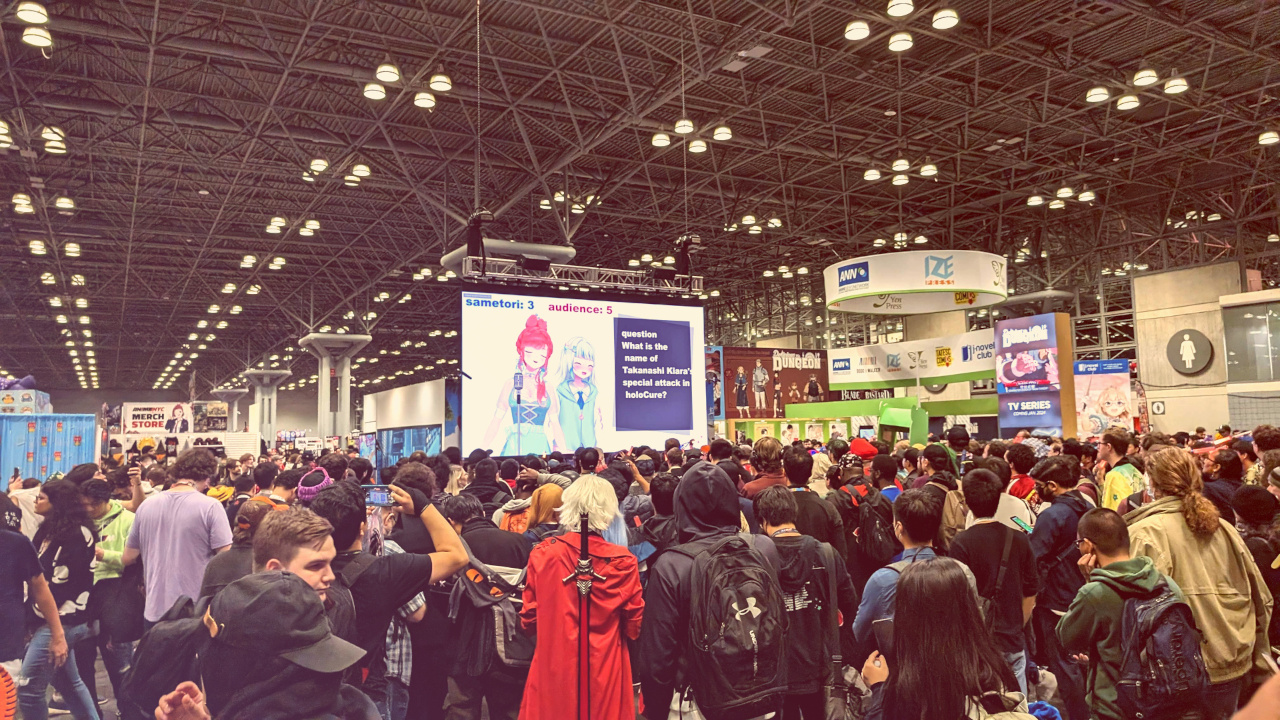Love ‘Em or Hate ‘Em, This One Niche Is Now a Core Part of Anime Conventions
You may recognize a few of these names.

Just a few minutes after wolfing down our breakfast, my friends and I made our way to the expo hall floor at Anime NYC, only to be immediately confronted by a new staple of the experience.
For my one friend, this was her first major con in a decade, and I wanted her to have the best experience imaginable. I planned out the day for her in advance, making sure she, as a Genshin Impact and Honkai: Star Rail fan, had plenty of time to check out the plethora of merch in the artist alley. So perhaps it was fitting that the very first thing she saw on Sunday was neither Venti nor Kafka, but an enormous crowd thronged around a big projector screen, watching Hololive VTuber duo Fuwamoco entertaining congoers.
The audience cheered and roared as Fuwawa and Mococo Abyssgard played off one another and bantered. For me, it cemented something I had heard an anime fan grumble about on Friday: VTubers have taken over the anime convention scene.
And that’s not necessarily a bad thing. Even if it left my friend a little bewildered.
Related: The 5 Best Mecha & Robot Anime of All-Time, Ranked on Attack of the Fanboy
So, was VTubing really that big at Anime NYC?
I’d consider myself pretty familiar with the VTuber landscape at this point. I’m an on-again, off-again VTuber myself, originally streaming Genshin for a lesbian audience, now in the process of pivoting over to Valorant streams. Several of my IRL friends are current or former independent VTubers, and I even met my last partner through VTubing. I’ve long guessed that VTubing is here to stay, given the enormous success of streamers like VShojo’s Ironmouse and Hololive’s Inugami Korone.
But the enormous VTubing presence at Anime NYC still took me by surprise. Unlike Genshin Impact and Honkai: Star Rail, VTuber agencies engaged in far more direct advertising at November’s convention. Hololive took prime real estate at one of the expo hall entrances, but the Japanese VTuber agency also made its appearance known through promotional kiosks for an iBuyPower gaming rig themed around Mori Calliope, as well as a Hyte case featuring Watson Amelia.
Meanwhile, over at the iBuyPower booth, custom keyboard creator Infinikey showed off several VShojo-themed keyboards, featuring such immensely popular stars as Ironmouse and Zentreya.
Hololive also offered a special ticketed event with Hoshimachi Suisei and Mori Calliope, a convention debut for the Hololive English Advent generation of VTubers, and a VRChat-Hololive collab event with several VTubers. The agency went out of its way to make sure Hololive fans had plenty of opportunities to gush over their favorite stars.
Outside of company partnerships and dedicated events, VTuber merchandise could be found throughout the larger retail section of the show floor, with VShojo in particular receiving an enormous, dedicated collection at one booth. But the biggest VTuber takeover of Anime NYC was at the artist alley, where Hololive and Nijisanji thrived. Like Genshin, both VTuber agencies were practically unavoidable; every other booth had key charms or artwork dedicated to the two groups’ various VTubers.
Artists and companies alike know VTubers have a dedicated, loyal fanbase eager to purchase anything related to their favorite streamers. One could argue that VTubing is practically a core part of the anime convention circuit at this point. Whether anime fans love it or hate it, the phenomenon sits at the perfect intersection of anime, video gaming, and streaming.
What brought about the VTuber takeover?
Two years ago, I suspected VTubing would gradually dominate the convention world. While the phenomenon wasn’t exactly apparent at PAX East 2022, VTubers were already getting plenty of attention at Anime NYC 2021—including a wide swath of Crunchyroll Hime VTuber advertisements throughout the Javits Center. But there’s a difference between a growing niche, and a practically unavoidable part of anime culture. VTubing is becoming the latter, with Hololive merch now a near-mandatory inclusion for artist alleys at cons.
VTubing first came about in the 2010s, but the format famously grew in popularity during the quarantine phase of the pandemic. According to an April 2023 report on Pulsar, VTubing has seen constant, growing interest on both Twitter and Google Search since March 2020. Meanwhile, Hololive expanded in profitability during its last fiscal year, nearly increasing its revenue to 50 percent compared to the year prior. In the long term, Hololive plans to expand on its VTuber brands by offering an “anime-style metaverse” experience in 2024.
VTubing is in a strange spot right now. VTuber viewer hours dipped slightly on Twitch in late 2022, although interest remains high. One anonymous Nijisanji streamer told Polygon that VTubing “has become less novel as the market has become more saturated.” Indie VTuber NagamiMugi argued VTubing “has become kind of stale,” and that VTubers “need to branch out and create more content in line with other influencers,” like reviews and video essays.
I’m confident VTubers can overcome these hurdles, however. As Twitch’s APAC content director said in October, VTubing is an accessible option for all sorts of new streamers, as it “gives people that are a bit more private a way to still be expressive on stream.” In many cases, all you need is a gaming PC, a stable internet connection, and a PNG image to start VTubing.
No doubt, the corporate-backed VTubers at Hololive, Nijisanji, and VShojo will always have greater resources, greater opportunities, and greater popularity than their indie counterparts. Yet, Anime NYC showed me that there’s a real hunger for VTuber content, and that the field is not simply a neat pandemic novelty to tuck away now that people are going outside again. Anime fans love these virtual anime girls, and I’m expecting to see even more of them in the year ahead.
(featured image: Ana Valens)
Have a tip we should know? tips@themarysue.com